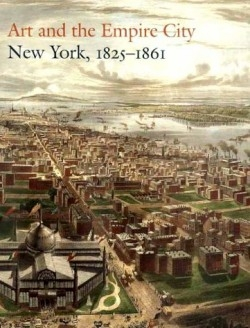Art and the Empire City
New York, 1825-1861
In 1827, an author of “Letters Descriptive of New York, Written to a Literary Gentleman in Dublin” published in the New-York Mirror and Ladies’ Literary Gazette posed the question, “What did it mean to be the Empire City, ‘the greatest commercial emporium of the world?’” This magnificent and lavishly illustrated volume answers that question in terms of urbanity and the arts in rich historic detail.
In his fascinating opening essay, “Inventing the Metropolis: Civilization and Urbanity in Antebellum New York,” Dell Upton explains that the opening of the Erie Canal in 1825 guaranteed New York City’s future as the preeminent, “geographical and financial center of a web of national and international commerce.” The reader learns how the interwoven forces of urban planning and development, and an economic boom led to the marketing of culturally exclusive “high” art, as well as the huckstering of art as bourgeois entertainment for the masses during this pre-Civil War period.
Subsequent essays by an array of distinguished scholars, all beautifully illustrated and documented with extensive notes and appendices, explore how private collections and public exhibitions blossomed during this period, while exciting new developments in New York landscape painting, sculpture, architecture, photography, fashion, home decor, furniture, ceramics, glass and metal ware burst into the expanding marketplace. Such revelations about this historic period help to explain the contemporary perception of New York as the arts capital of the world.
This exquisite catalogue appears concurrently with a massive exhibition this fall by the same title at the Metropolitan Museum of Art on Fifth Avenue in Manhattan. Should one be so moved to attend the exhibit, this book will provide a brilliant record of the experience. For those who don’t reach New York this fall, the cultural wealth of the exhibit and then some can be held in hand.
Reviewed by
Bronwyn Jones
Disclosure: This article is not an endorsement, but a review. The publisher of this book provided free copies of the book to have their book reviewed by a professional reviewer. No fee was paid by the publisher for this review. Foreword Reviews only recommends books that we love. Foreword Magazine, Inc. is disclosing this in accordance with the Federal Trade Commission’s 16 CFR, Part 255.

